Gucci has seen a huge revival under Creative Director Alessandro Michele. He brought in a whole new aesthetic to the house that became a rage the world over. His most recent statement T-shirt collaboration with 24-year old artist Coco Capitan has been an equally huge success. One of the most iconic statements from this collection reads « What are we going to do with all this future? » Well Gucci seems to be headed in a direction to make the future greener. In the latest Kering talk, Gucci announced that as of 2018 it will be going fur free.
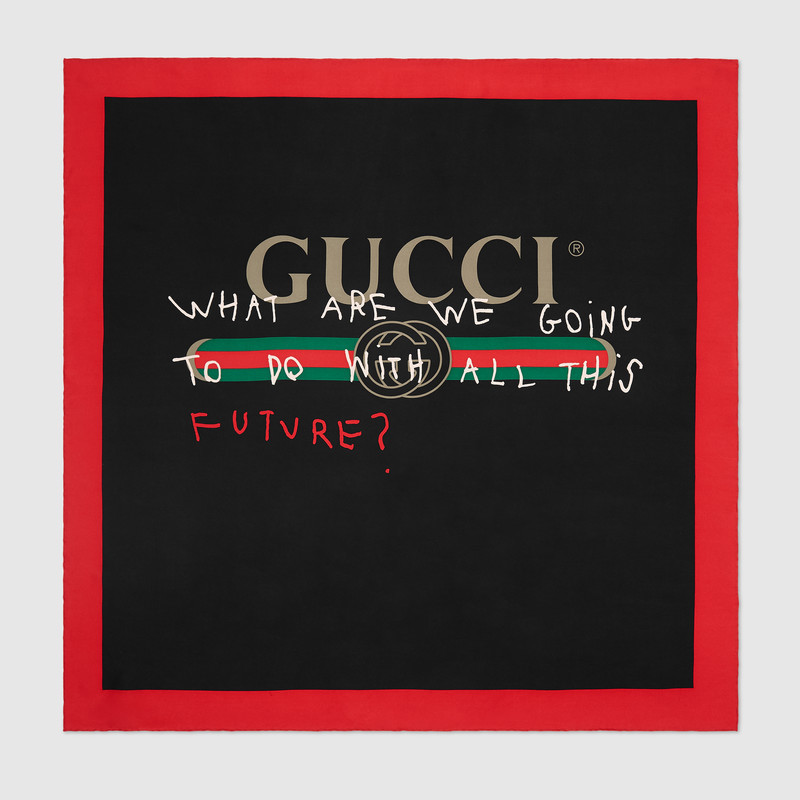
CococCapitan scarf on Gucci website
With conscious-living catching on as the biggest trend across lifestyle verticals, fashion labels, from high-street to luxury ones are busy cleaning and greening up their act. From sustainable ops, to eco-materials, CSR to even taking back clothing, cutting fashion shows and going fur-free, brands are broadcasting their latest green act to appeal to our « woke » green selves. Armani had announced going fur-free while Burberry and Vetements had announced cutting down fashion shows to cut wastage. Recently Vetements did a green window display at Saks Fifth Avenue. Instead of the elaborate artistic displays, there was just a pile of clothes. All the clothing was donated by Saks employees or out-of-date merchandise, to be given to RewearABLE, a program designed to provide sustainable employment for adults with developmental disabilities that also recycles clothing. Each day, the pile was added to, expressing excess and consumerism in fashion.
So this year, when Gucci being the hottest brand, decided to ditch fur which is a huge business opportunity, it was a huge surprise. But what is the conscious quotient of Gucci? Is it rising at same pace as its profits? We decode it here..
Gucci’s fur-free mic-drop moment
PETA hounded Gucci for over two decades to give up its use of fur. In fact, the one footwear that’s practically on every celeb and fashion blogger’s foot is the Gucci fur-lined loafer made from Kangaroo fur.
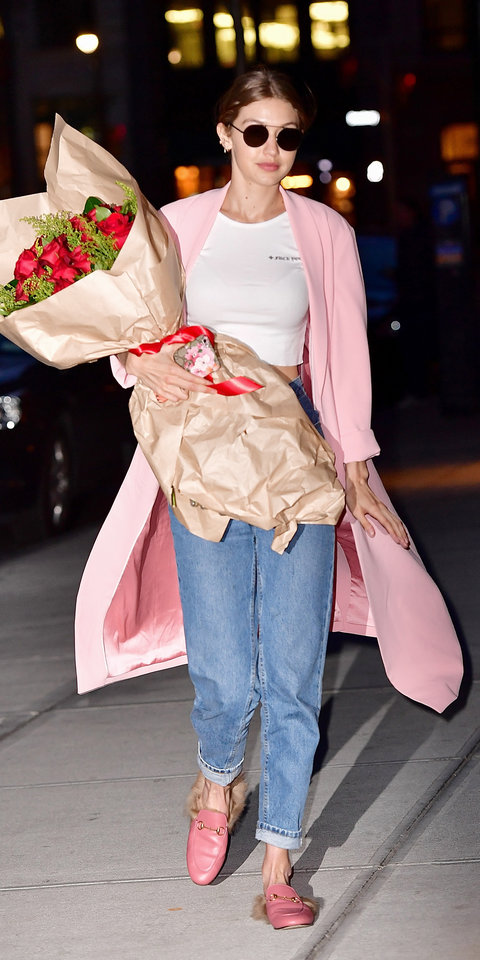
Gigi Hadid in Gucci fur-lined loafers: Source
Finally on the occasion of the International Day of the Girl on October 11, in the Kering Talk organized at the London College of Fashion, Marco Bizzarri, the CEO and president of Gucci, announced that as of 2018, the Italian fashion house will go fur-free, banning the use of coyote, mink, fox, racoon, rabbit, and other species bred or caught for the purpose of fur. Gucci will also auction off their remaining stocks and items of fur, the proceeds of which will be donated to animal rights organisations, LAV, and Humane Society International. While there was counter-criticism, (especially in China where Kering is making special effort through WeChat app to educate its Chinese consumer-base on sustainability), saying this is just a marketing ploy because Gucci is not even recognized for fur products, we say any green news is good news! Bizzarri and creative director, Alessandro Michele, will explore & experiment with faux-fur, wool, and cutting-edge new fabric innovations further.
So what’s the big-deal about going fur-free?
Going fur-free is a big green deal. For the same reason that reducing meat-consumption is. Because livestock farming is big source of global pollution.
Being a green-enthusiast yourself, we are sure by now you are aware that pollution happens at across stages – from raw material, manufacturing, transportation to even retail design and packaging. Now let’s pause at raw materials. Take the pristine angelic looking cotton for example: despite its super natural image, cotton is actually the dirtiest crop on the planet. It uses more chemical pesticides than any other, e.g. 25% of all insecticides. It is also particularly a very very thirsty crop: one needs roughly 2.700 liters / 720 gallons to produce the cotton needed to make a single t-shirt, this is equal to what a person drinks in 3 years.
Similarly, fur is not only cruel, but an equally polluting raw material. The World Bank lists fur dressing as one of the world’s five worst industries for toxic-metal pollution.
- 85% of fur comes from fur farms, meaning more than 45 million animals worldwide, including raccoon dogs, rabbits, foxes, mink, and chinchillas, are raised in cages and killed each year for their fur.
- Fur production is also intensely polluting and energy-consuming. Animal skin needs to be treated with toxic chemicals so that it does not rot. Toxic fumes besides being released in the environment (which is bad), can also be absorbed by us through air and skin in our body (which is bad) from the residues.
So it’s very clear that fur-free is an important green move.
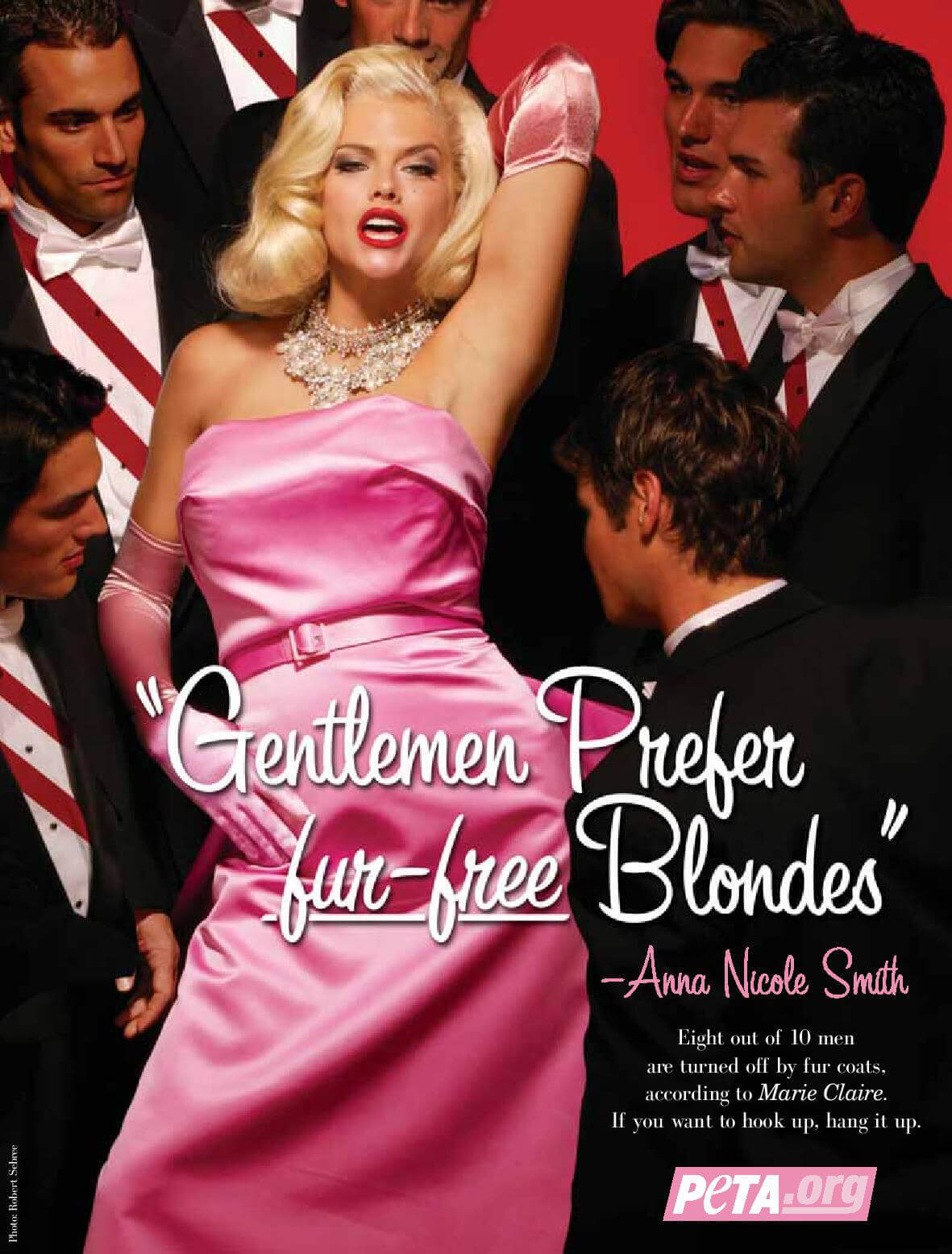
Peta ad: Source
Peta France ad: Source
So what made Gucci go G for Green…
One side of this green announcement doesn’t surprise us, because the parent company that owns Gucci – Kering – has recently been lauded as the luxe posterchild of sustainability. Kering also owns Stella McCartney which is known for it’s commitment to leather-free products and sustainable fashion. Similarly in 2014, Saint Laurent, introduced a eco programme to reduce the environmental impacts of its stores. The implementation of best practices from lighting, heating and air conditioning systems has enabled Saint Laurent to improve the energy efficiency of the brand’s global store network by 37% between 2013 and 2015.
Earlier this year, Kering was unveiled as a strategic partner of Global Fashion Agenda, to lead the global sustainability conversation and create a platform to share new industry standards. Guided by the UN Sustainable Development Goals, Kering has also announced quantifiable 2025 targets in its strategy. Kering has committed to reduce their GHG emissions by 50 % by 2025. Kering aims to create a supplier index of sustainability which will ensure that the high standards for raw materials and processes are being implemented by the suppliers at 100 %. – a step up on traceability, animal welfare, chemical use and social welfare. A Materials Innovation Lab (MIL) will be established to focus on sustainable production of watches and jewellery.
Now whether one says this is simply a marketing ploy or genuine green move, with fashion being the second biggest polluting industry, it’s imperative that all brands globally march in this direction. In fact, at the 5th edition of Copenhagen Fashion Summit – the Global Fashion Agenda‘s flagship event – a new report was published that gave updates on fashion industry’s latest figures. At this world’s most important event on sustainability in fashion, where the major fashion industry decision-makers at a global scale, from C-suite level executives, policy-makers to designers, buyers & influencers convened, the Pulse Report was released in collaboration with The Boston Consulting Group. It made an in-depth assessment of the industry’s environmental and social performance. The €1.5 trillion fashion industry is one of the most resource and labour intensive industries in the world.
Some of the shocking figures & findings unveiled, basis the current trends in population and GDP growth, indicated a consumption rise in global apparel and footwear from 62 million tons to 102 million in 2030! This growth in fashion production will contribute to a direct increase on natural and social resources.
- Water– It is a key resource in fashion, both in cultivating the natural fibers and in processing the fabric. The report estimates that the industry’s annual water consumption under current practices will rise 50% by 2030 – a date when the World Bank expects the global shortfall between demand and supply to reach 40%.
- Energy emissions– Already, atmospheric CO2 is 20% beyond what is considered safe, and the report pegs fashion’s annual emissions to increase 60% by 2030.
- Chemicals– In fashion these include fertilizers, pesticides, and a variety of dyes and processing agents. Looking at occupational illnesses due to carcinogens and airborne particulates, working conditions and natural resources are in for deterioration if advanced chemicals management isn’t implemented.
- Waste – If current practices are continued by 2030 fashion’s annual waste from production and consumer disposal will increase by 60%.
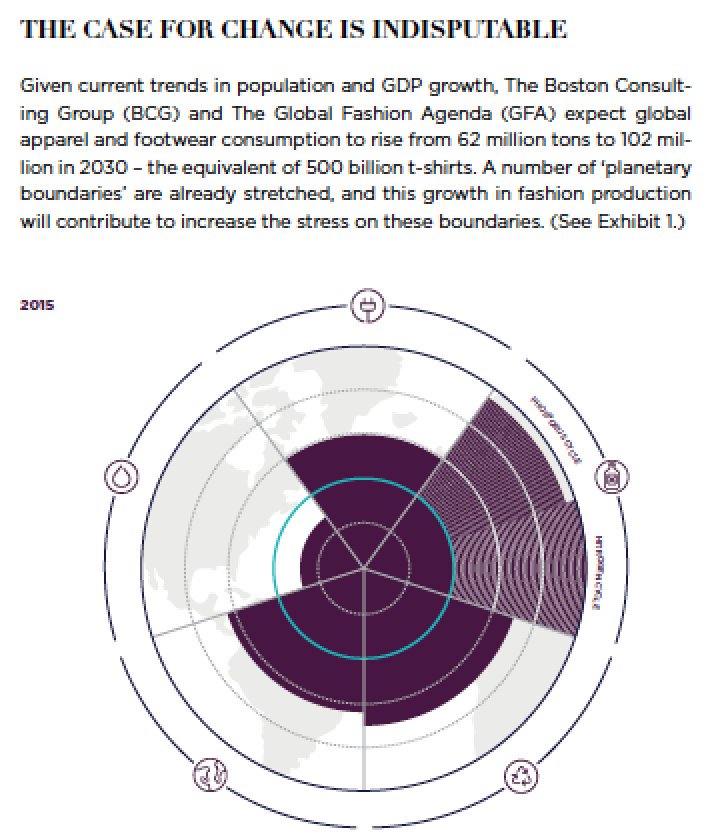
Some of the other findings of the report also challenge conventional wisdom!
- Sustainability is not a luxury that only premium-priced brands can afford. Company size, far more than price positioning, correlated with a higher eco score.
- ‘Fast fashion’ isn’t necessarily a threat to the environment & society: the large entry-price high-street brands all achieve solid scores. Small and mid-sized fashion brands in contrast, which collectively comprise more than half of the industry, rate poorly.
- By geography, European brands score higher on environmental dimensions, while their U.S. counterparts are more likely to follow social best practice.
Considering Kering group is a strategic partner of the GFA and it published learnings from it’s own green measures and has 2025 targets, it was setting a big example by making the hottest brand in its portfolio go fur-free. Especially when fur could have been a huge money-making opportunity with Gucci’s already north moving profit figures. Owing to Gucci, Kering had a 23 percent lift in revenue, to $4.6 billion.
The not-so-green news
While going fur-free is definitely a cool green & ethical move, there’s a lot of other aggressive developments that challenge Gucci’s green image. Example – Gucci’s Art Lab. To ensure that profits grow, the Kering group’s priority is to realign Gucci’s production cycle. To respond faster to customer demand, to support that rate of production, shorten lead times and move the brand closer to being a vertically integrated organization, the company is in the process of opening the Gucci Art Lab, a design and production facility, in early 2018. It will be a 35,000-square-foot space in Italy, specializing in manufacturing leather goods and shoes, responding to customer trends, sourcing sustainable materials and keeping the Gucci supply chain closer to home, to speed up the rate at which new capsule collections can be released. While fast-fashion has been heralded as an environmental demon, we are yet to fully understand how this will impact Gucci’s green score as it also seems to put sustainable materials first.
So where does the industry & Gucci’s competitors stand on fur?
As we mentioned further above, Gucci going fur-free news was counter-criticized as a marketing ploy. Wondering for who? Marketer’s favorite buzzword – millennials.
Did you know! Gucci’s senior management, in fact, works with the influence of the « shadow committee » – a committee of young people below the age of 30, that gives Bizzarri a different perspective than his normal circle of top executives at Gucci. The task is either discussing the same topics that the top execs discuss in the normal meetings or giving ideas on different processes.
One of the key descriptor’s of millennials is that they are a socially and ethically conscious generation. They identify sustainability as one of the key factors in purchase pattern. But here’s the surprise! While there’s popular belief of brands going sustainable globally owing to the « ethical » millennial consumers, there’s conflicting angle. Fur is actually seeing increase as a trend and in sales. We all know that famously Fendi & Karl Lagarfeld have been challenged for staying firm on fur, but have refused to budge. Fur isn’t just a fabric of choice for coats now. Owing to its popularity, it’s fast-becoming an accessory & embellishment – like military parkas hoodies lined with fur, bag charms, shoe linings, etc. Fendi’s Bag Bugs charms, for example, led to months-long waiting lists.
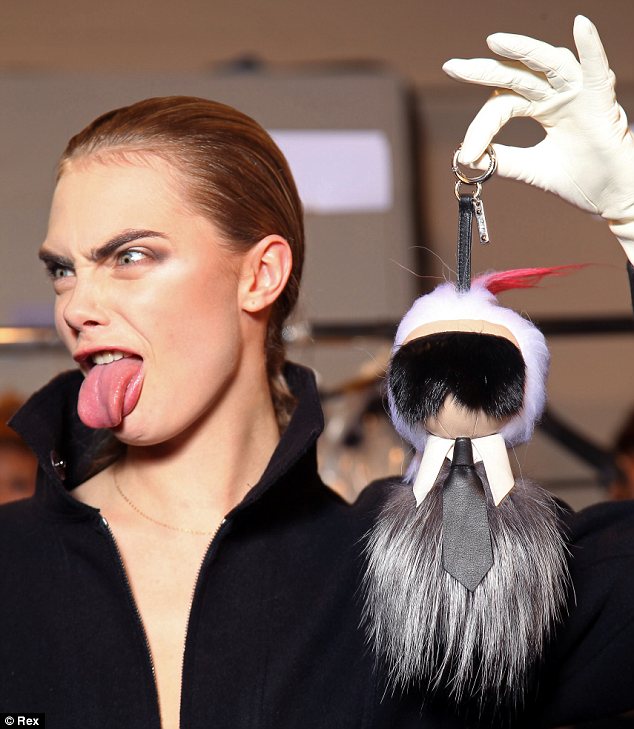
Karlito fur bag charm: Image source
Add to that celebs sporting fur unabashedly, has also influenced people. Celebs, such as Rihanna who while famously wore Dior’s We should all be feminists tee to Trump’s Women’s March also wore fur throw that drew criticism. With celebrities such as Rihanna, Kim Kardashian West and Beyoncé, wearing fur relentlessly, the unethical material is gaining a renewed popularity. Retailers like Harrods or Harvey Nichols are all for fur, and fur in online retail has increased 30 percent.
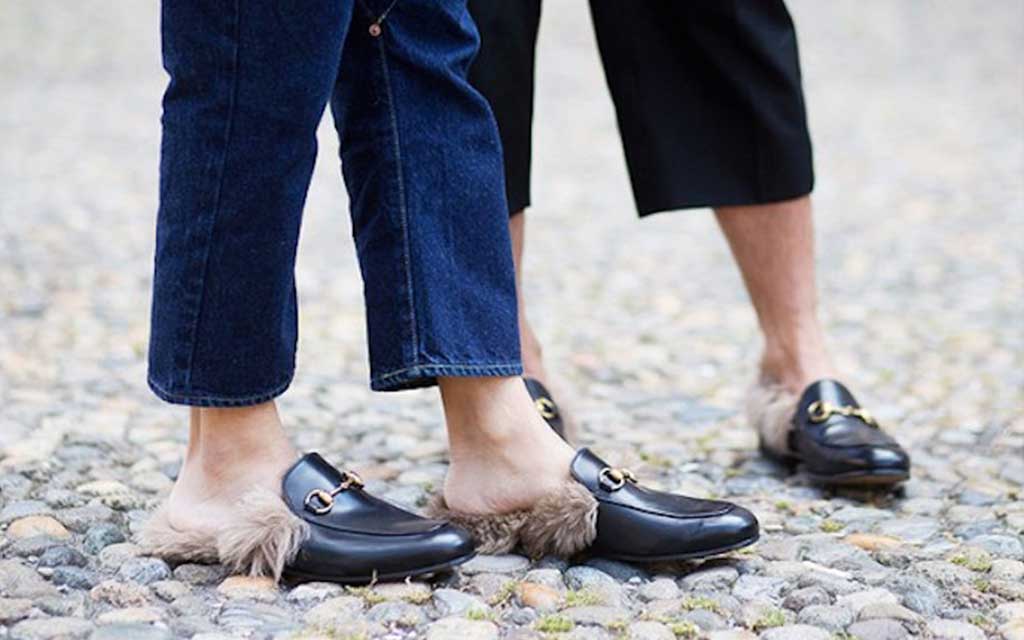
Gucci’s fur-lined loafers: Source
Rihanna at Women’s March wearing fur stole: Source
So is faux-fur the future?
C-Suite team at Gucci – Bizzari and Alessandro Michele have said besides other material Gucci will invest in exploring faux-fur. In the US, the market has grown 2 percent from 2012 to 2016 and is now worth $114.6 million. While we wait to see what Gucci has in store, faux-fur has its own downside.
- Some fur makers contend that faux-fur is worse for the environment than the real thing as it’s made from plastic and non-renewable petroleum-based products, such as nylon, acrylic and polyester, then treated with heat and chemicals.
- Add to that the curent pace of fast-fashion, consumers dispose off the cheaper faux-fur garments after one season of wear. Like most fashion waste, faux-fur items also end up in landfill and, just like all petroleum-based plastic bags, can take up to 1,000 years to decompose.
- Washing fake fur can harm the environment, too. With every machine wash, each garment releases an average of 1,900 tiny particles of plastic, which are then swilled into rivers, lakes and, eventually, the sea.
- Finally the mother of all horrors – the faux-fur may actually be real fur!! Yes! Read about some of the faux-fur exposes, if you have the heart and stomach to.
Our recommendation – Go 100% fur-free
GREEN TIP: To check which brands are fur-free, www.furfreeretailer.com is a good platform – a program that recognizes and supports retailers who have committed to a no-fur policy. Good news is that big retailers like H&M Group, Inditex (which owns Zara), Topshop, Zalando and even prestigious ones like Net-a-Porter and Selfridges are all part of the Fur Free Alliance’s Fur Free Retailer Program.
In the end, there’s no excuses for not giving ethical and eco clothes a chance to make space in your closet. So instead of getting into trappings of what works and what doesn’t, we can all simply ditch fur (and faux) and still stay on-trend. We cheer Gucci’s move, ditch fur and now can we all move on to upping our wardrobe’s eco-conscious quotient! Here’s founder Mirela’s tips to go green and stylish!


![[GREEN FASHION] Gucci goes fur free & how you can too! [GREEN FASHION] Gucci goes fur free & how you can too!](http://urbanmeisters.com/wp-content/uploads/bfi_thumb/dummy-transparent-pyhloy3hjs3c3k501os93xguzzexev7mk3dm4slhuc.png)
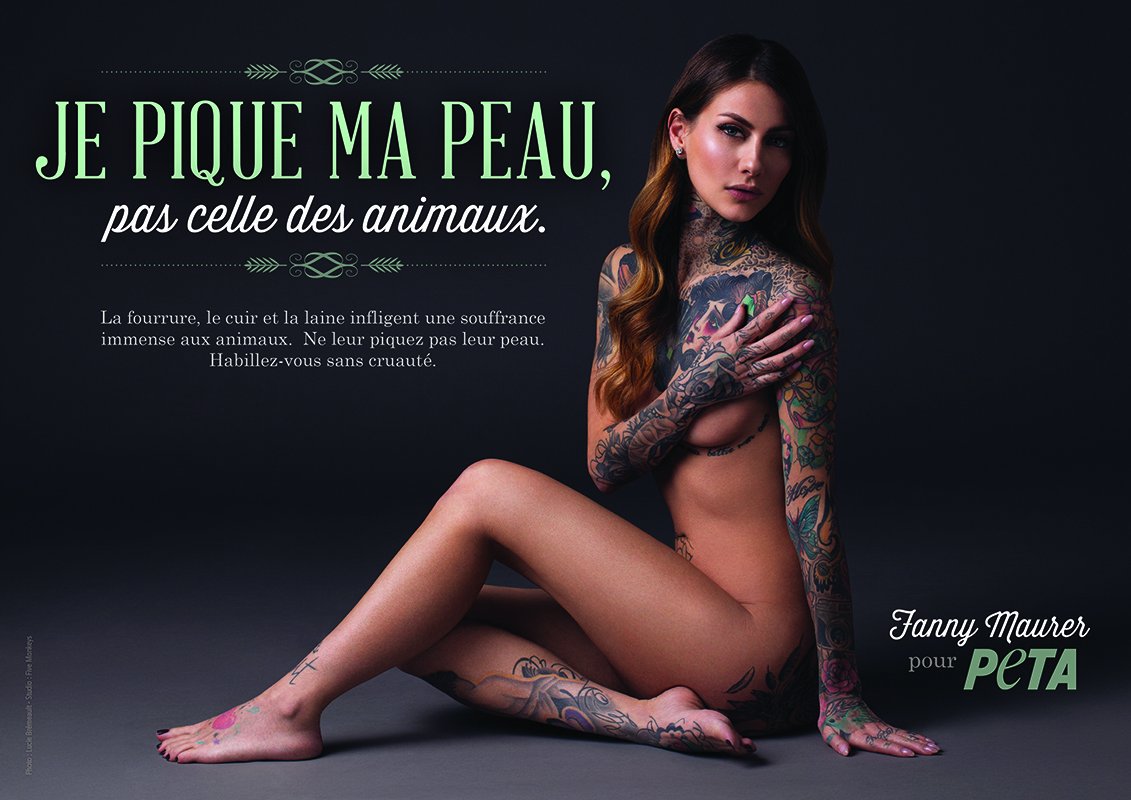

![[ALERTE GREENWASHING – CHAMBRE ENFANT] Les conseils pratiques d’un père engagé](http://urbanmeisters.com/wp-content/uploads/bfi_thumb/dummy-transparent-pyhloyclal4p5ty8tb4matytlyd4xyugzcd2z17fr6.png)

